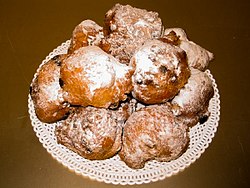Oliebol: Difference between revisions
No edit summary |
|||
| Line 45: | Line 45: | ||
*[[Doughnut]] |
*[[Doughnut]] |
||
*[[Fritter]] |
*[[Fritter]] |
||
*[[Æbleskiver]], a similar Danish dish. |
|||
==References== |
==References== |
||
Revision as of 14:10, 21 September 2014
 | |
| Type | Doughnut or dumpling |
|---|---|
| Place of origin | Netherlands, Belgium |
| Main ingredients | Flour, eggs, yeast, some salt, milk, baking powder; usually sultanas, currants, raisins; zest or succade |
| Variations | Appelbeignet |
An oliebol (Dutch pronunciation: [ˈoːlibɔɫ], plural oliebollen ) is a traditional Dutch and Belgian food. They are called oliebollen (literally: oil spheres) in the Netherlands, while in Belgium they are called smoutenbollen (literally: lard balls although the real "smout" is of rapeseed oil) in Dutch and croustillons (loosely: crispies) in French. In English they are more commonly known as Dutch Doughnuts or Dutchies. In the distant region of Istria, now split into the countries of Italy, Croatia and Slovenia, a variation of this dish is called fritole, fritule and blinci. In Serbia they are called uštipci.
Oliebollen are a variety of dumpling made by using an ice-scooper or two spoons to scoop a certain amount of dough and dropping the dough into a deep fryer filled with hot oil. In this way, a sphere-shaped oliebol emerges. Oliebollen are traditionally eaten on New Year's Eve[1] and at funfairs. In wintertime, they are also sold in the street at mobile stalls.
The dough is made from flour, eggs, yeast, some salt, milk, baking powder and usually sultanas, currants, raisins and sometimes zest or succade. A notable variety is the appelbeignet which contains only a slice of apple, but different from oliebollen, the dough should not rise for at least an hour. Oliebollen are usually served with powdered sugar. In Flanders the "oliebol" is called "smoutenbol" where as the only difference is not baked in vegetable oil, but in animal fat. Another difference between the Dutch oliebol and the Flanders smoutenbol is that the smoutenbol is usually not filled in contrast to the Dutch oliebol. The filling of the oliebol could consist of raisins, currants and apple, other ingredients can be added, such as Succade, pieces of orange or whip cream.
Origin
They are said to have been first eaten by Germanic tribes in the Netherlands during the Yule, the period between December 26 and January 6 where such baked goods were used. The Germanic goddess Perchta, together with evil spirits, would fly through the mid-winter sky. To appease these spirits, food was offered, much of which contained deep-fried dough. It was said Perchta would try to cut open the bellies of all she came across, but because of the fat in the oliebollen, her sword would slide off the body of whoever ate them. It is also said that the oliebollen come from Portugal. It is suspected that the Portuguese Jews during the Spanish Inquisition fled to the Netherlands with their recipes. In Portugal at that time, there was already something similar to the oliebol: (dried) Southern Fruits.[2]
From oliekoek to oliebol

For centuries the Dutch ate oliekoek ("oil cake"), an old name for oliebol. The Oliebollen you see in the painting from around 1652 are very similar to today's oliebol. At that time, they were baked in Lard or Raapolie. During the nineteenth century the word "oliebol" started to be used more. In 1868 Van Dale, a famous Dutch dictionary, put the word "oliebol" in its dictionary. But it was not a commonly used word yet said by "Woordenboek der Nederlandsche taal" (1896), which is another Dutch dictionary. In that dictionary they say that "oliekoek" is a more commonly used term, but then there was a major change and from the early twentieth century the word "oliekoek" was not used anymore and had been replaced by "oliebol".
Croustillons
A very similar type of oliebol can also be found in the Walloon part of Belgium, Brussels and northern France. Croustillons are deep fried dough balls served hot and liberally sprinkled with powdered sugar. They are usually served in a paper cone with a little plastic fork to eat them with. They are typically found at fairgrounds in Belgium and in Lille, France.
Oliebollentest
Since 1993 Dutch newspaper Algemeen Dagblad has held an annual highly publicized oliebollentest at the end of each year. In 2012, the bakery of Willy Olink from Maarssen won the test.[3] In 2013 Richard Visser won the test for the ninth time in twenty years.[4]
See also
- Poffertjes
- Vetkoek
- Doughnut
- Fritter
- Æbleskiver, a similar Danish dish.
References
- ^ Sijs, Nicoline van der (2009). Cookies, Coleslaw, and Stoops: The Influence of Dutch on the North American Languages. Amsterdam UP. p. 135. ISBN 978-90-8964-124-3.
- ^ Oliebollen en oliekoeken Template:Nl icon
- ^ Template:Nl "Visser opnieuw winnaar oliebollentest". NOS. December 27, 2011. Retrieved December 31, 2011.
- ^ "AD Oliebollentest 2013". Algemeen Dagblad. 2013. Retrieved 31 December 2013.

